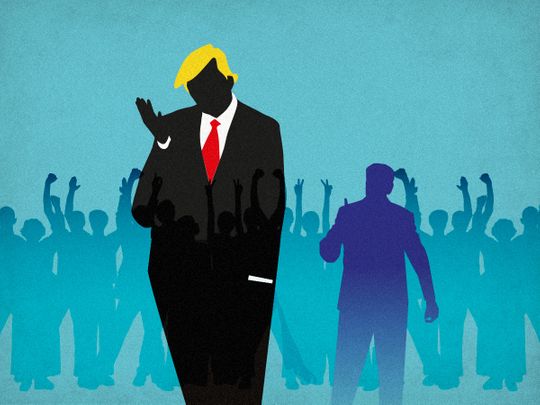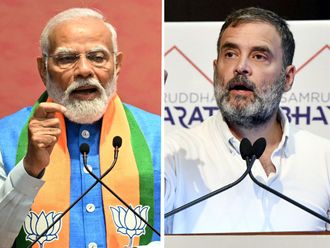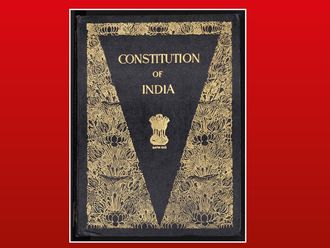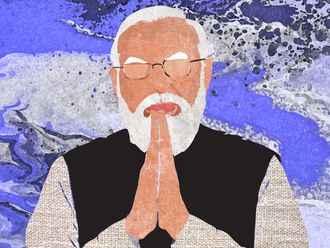
Win or lose on November 3, Donald Trump has already reserved his spot in history. Like him or not, the 45th president of the United States will be remembered as the man who galvanised American politics in a way only few other politicians can claim of.
No American politician, perhaps since the election of John F. Kennedy in 1960, has evoked such emotions that may very well dominate the American psyche long after he leaves office. Trump will always be remembered as a genuinely polarising figure who awakened nationalist passions Americans thought they had buried deep over years of an incessant progressive tide with the elections of such liberals as Bill Clinton and Barack Obama.
When Black Lives Matter protests gripped the country following the death of a black man at the hands of white policemen, it was fundamentally seen as a natural reaction to the rise of the Trump nationalist phenomenon, which led the way to the resurgence of white supremacists and anti-minorities sentiment. Groups such as the Proud Boys, the Patriotic Movement, and the Three Percent — essentially names of far-right armed militias, have of late become part of the political discourse.
Over the weekend, a court in Michigan charged Barry Croft, a white supremacist and active member of the Three Percent, and five others with “domestic terrorism” plot to kidnap Michigan Democratic Governor Gretchen Whitmer and a plan to storm the government buildings to “overthrow the state government”.
The Michigan case might help researchers understand the thinking and actual ability of armed militias in the US. Researchers have been warning about the rise of the threat posed by these groups especially in an election that pits one half of the country against the other in a way America may have never seen before. Such schism has of course been heightened by political tension over the response of the Trump administration to the coronavirus outbreak and the economic downturn which led to record number of unemployment and the summer anti-racism protests.
Growing domestic terrorism
Months before the Michigan arrests, the Centre for Strategic and International Studies (CSIS) said the US “faces a growing terrorism problem that will likely worsen over the next year.” In the June report, the CSIS said based on its data set of terrorist incidents, the most significant threat likely comes from white supremacists and that over the rest of 2020, the terrorist threat in the US “will likely rise based on several factors, including the November 2020 presidential election.”
There is no evidence of course that links the Michigan plot directly to Trump’s policies or speeches, who on few occasions condemned such acts of terror. But Whitmer, the Michigan governor, expectedly put the blame squarely on the president. She referred to his call, during last month’s debate with Joe Biden, to the Proud Boys to “stand back and stand by”.
“Hate groups heard the president’s words not as a rebuke, but as a rallying cry. When our leaders speak, their words matter. They carry weight. When our leaders meet, encourage or fraternise with domestic terrorists, they legitimise their actions, and they are complicit. When they stoke and contribute to hate speech, they are complicit.”
Conspiracy theories
The Trump speeches have no doubt evoked nationalist sentiments. When he speaks of radical left conspiracy to take over America to “take away your religion”, abolish the right to bear arms, restrict individual freedoms and open the door to immigrants, white groups may think it is their ‘constitutional duty’ to fight back.
A little known European-born conspiracy theory, the Great Replacement, has over the past few years found many believers in the US. The theory claims that, with the complicity or cooperation of the ‘liberal elites’, the white European population at large is being progressively replaced with non-European peoples, specifically Arab, Berber and sub-Saharan Muslim populations from Africa and the Middle East through mass migration, demographic growth and a European drop in the birth rate.
In August last year, Patrick Crusius, a 21-year-old white supremacist and subscriber to the Replacement Theory, opened fire in a Walmart store in El Paso, Texas, and killed 23 people, mostly immigrants of Mexican origin. In online notes he posted before he committed the massacre, he said he was inspired by the mosque massacre in Christchurch, New Zealand, in which a white terrorist shot and killed 51 Muslims during Friday prayers.
Far-right extremism
Terror based on extremist religious or racial tendencies has been rife well before the Trump presidency. Al Qaida, Daesh, white supremacists, and many other terrorist groups existed and wreaked havoc for decades. But it is perhaps one of those rare occasions in history when such tendencies are inspired by a mainstream politician — particularly one who occupies the highest office in the world, the White House. President Trump, for all fairness though denied repeatedly that he will ever condone extremist behaviour.
But in his clear Machiavellian pursuit of retaining power, he realises that his chances of re-election mainly rest with white America — and not any white; the ‘Salafi’ white America. Similar to those Muslim Salafists who seek a puritan society that mirrors in their view the early days of Islam, a world ruled by Sharia only, the white Salafis dream of an America that is purely white; a segregated America well before the civil right movement and ‘liberal onslaught.’
As the presidential election nears, it is less than three weeks away, it will be important to watch the far-right dynamism, the behaviour of the white Salafis of America.
The race to the white House looks increasingly tight, despite the early Biden lead in the polls. Yet it is far from over. But even if President Trump loses the election, there is not doubt that his impact on the American political, social and racial discourse will remain long after he has left the Oval Office.








